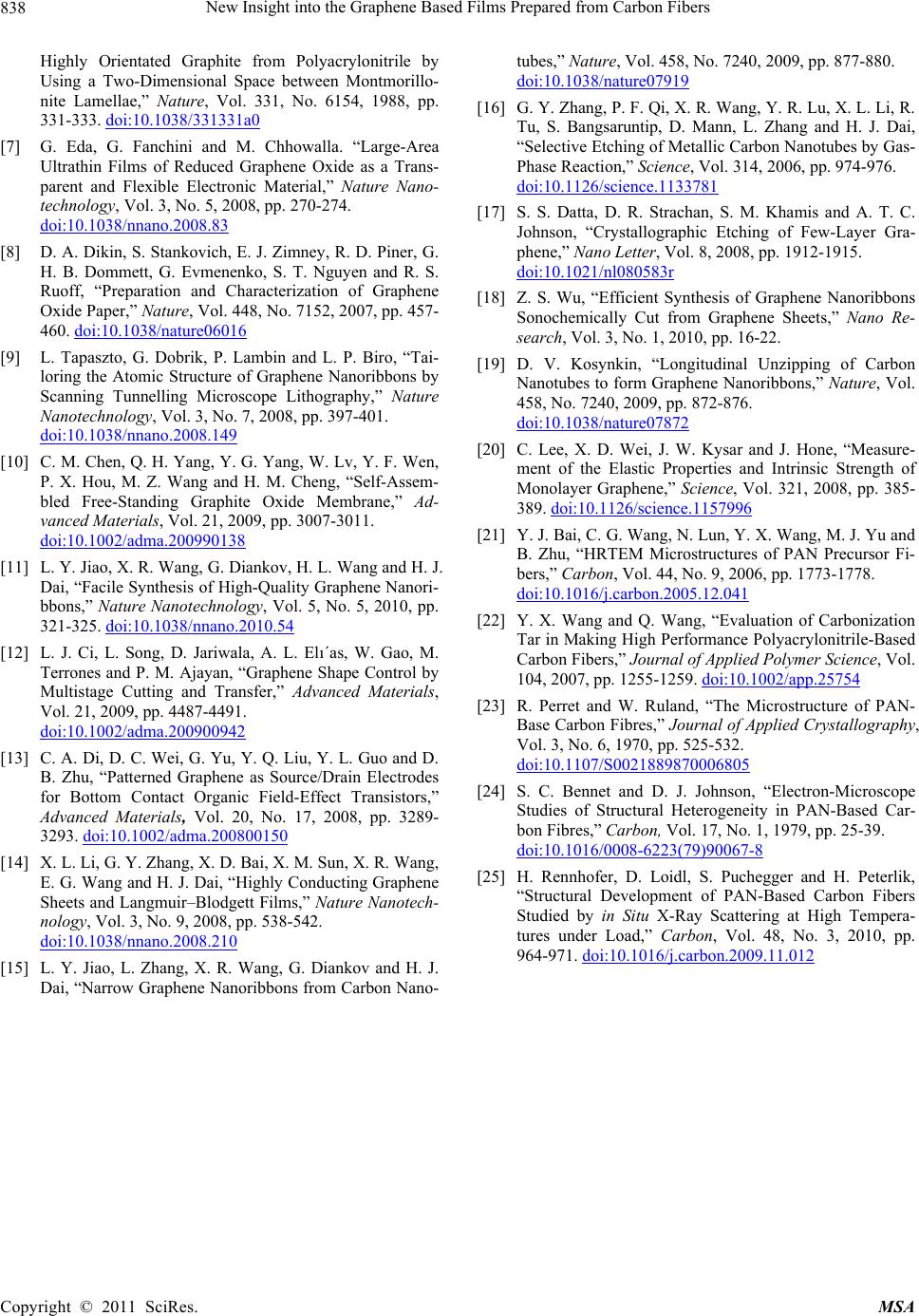
New Insight into the Graphene Based Films Prepared from Carbon Fibers
Copyright © 2011 SciRes. MSA
838
Highly Orientated Graphite from Polyacrylonitrile by
Using a Two-Dimensional Space between Montmorillo-
nite Lamellae,” Nature, Vol. 331, No. 6154, 1988, pp.
331-333. doi:10.1038/331331a0
[7] G. Eda, G. Fanchini and M. Chhowalla. “Large-Area
Ultrathin Films of Reduced Graphene Oxide as a Trans-
parent and Flexible Electronic Material,” Nature Nano-
technology, Vol. 3, No. 5, 2008, pp. 270-274.
doi:10.1038/nnano.2008.83
[8] D. A. Dikin, S. Stankovich, E. J. Zimney, R. D. Piner, G.
H. B. Dommett, G. Evmenenko, S. T. Nguyen and R. S.
Ruoff, “Preparation and Characterization of Graphene
Oxide Paper,” Nature, Vol. 448, No. 7152, 2007, pp. 457-
460. doi:10.1038/nature06016
[9] L. Tapaszto, G. Dobrik, P. Lambin and L. P. Biro, “Tai-
loring the Atomic Structure of Graphene Nanoribbons by
Scanning Tunnelling Microscope Lithography,” Nature
Nanotechnology, Vol. 3, No. 7, 2008, pp. 397-401.
doi:10.1038/nnano.2008.149
[10] C. M. Chen, Q. H. Yang, Y. G. Yang, W. Lv, Y. F. Wen,
P. X. Hou, M. Z. Wang and H. M. Cheng, “Self-Assem-
bled Free-Standing Graphite Oxide Membrane,” Ad-
vanced Materials, Vol. 21, 2009, pp. 3007-3011.
doi:10.1002/adma.200990138
[11] L. Y. Jiao, X. R. Wang, G. Diankov, H. L. Wang and H. J.
Dai, “Facile Synthesis of High-Quality Graphene Nanori-
bbons,” Nature Nanotechnology, Vol. 5, No. 5, 2010, pp.
321-325. doi:10.1038/nnano.2010.54
[12] L. J. Ci, L. Song, D. Jariwala, A. L. Elı´as, W. Gao, M.
Terrones and P. M. Ajayan, “Graphene Shape Control by
Multistage Cutting and Transfer,” Advanced Materials,
Vol. 21, 2009, pp. 4487-4491.
doi:10.1002/adma.200900942
[13] C. A. Di, D. C. Wei, G. Yu, Y. Q. Liu, Y. L. Guo and D.
B. Zhu, “Patterned Graphene as Source/Drain Electrodes
for Bottom Contact Organic Field-Effect Transistors,”
Advanced Materials, Vol. 20, No. 17, 2008, pp. 3289-
3293. doi:10.1002/adma.200800150
[14] X. L. Li, G. Y. Zhang, X. D. Bai, X. M. Sun, X. R. Wang,
E. G. Wang and H. J. Dai, “Highly Conducting Graphene
Sheets and Langmuir–Blodgett Films,” Nature Nanotech-
nology, Vol. 3, No. 9, 2008, pp. 538-542.
doi:10.1038/nnano.2008.210
[15] L. Y. Jiao, L. Zhang, X. R. Wang, G. Diankov and H. J.
Dai, “Narrow Graphene Nanoribbons from Carbon Nano-
tubes,” Nature, Vol. 458, No. 7240, 2009, pp. 877-880.
doi:10.1038/nature07919
[16] G. Y. Zhang, P. F. Qi, X. R. Wang, Y. R. Lu, X. L. Li, R.
Tu, S. Bangsaruntip, D. Mann, L. Zhang and H. J. Dai,
“Selective Etching of Metallic Carbon Nanotubes by Gas-
Phase Reaction,” Science, Vol. 314, 2006, pp. 974-976.
doi:10.1126/science.1133781
[17] S. S. Datta, D. R. Strachan, S. M. Khamis and A. T. C.
Johnson, “Crystallographic Etching of Few-Layer Gra-
phene,” Nano Letter, Vol. 8, 2008, pp. 1912-1915.
doi:10.1021/nl080583r
[18] Z. S. Wu, “Efficient Synthesis of Graphene Nanoribbons
Sonochemically Cut from Graphene Sheets,” Nano Re-
search, Vol. 3, No. 1, 2010, pp. 16-22.
[19] D. V. Kosynkin, “Longitudinal Unzipping of Carbon
Nanotubes to form Graphene Nanoribbons,” Nature, Vol.
458, No. 7240, 2009, pp. 872-876.
doi:10.1038/nature07872
[20] C. Lee, X. D. Wei, J. W. Kysar and J. Hone, “Measure-
ment of the Elastic Properties and Intrinsic Strength of
Monolayer Graphene,” Science, Vol. 321, 2008, pp. 385-
389. doi:10.1126/science.1157996
[21] Y. J. Bai, C. G. Wang, N. Lun, Y. X. Wang, M. J. Yu and
B. Zhu, “HRTEM Microstructures of PAN Precursor Fi-
bers,” Carbon, Vol. 44, No. 9, 2006, pp. 1773-1778.
doi:10.1016/j.carbon.2005.12.041
[22] Y. X. Wang and Q. Wang, “Evaluation of Carbonization
Tar in Making High Performance Polyacrylonitrile-Based
Carbon Fibers,” Journal of Applied Polymer Science, Vol.
104, 2007, pp. 1255-1259. doi:10.1002/app.25754
[23] R. Perret and W. Ruland, “The Microstructure of PAN-
Base Carbon Fibres,” Journal of Applied Crystallography,
Vol. 3, No. 6, 1970, pp. 525-532.
doi:10.1107/S0021889870006805
[24] S. C. Bennet and D. J. Johnson, “Electron-Microscope
Studies of Structural Heterogeneity in PAN-Based Car-
bon Fibres,” Carbon, Vol. 17, No. 1, 1979, pp. 25-39.
doi:10.1016/0008-6223(79)90067-8
[25] H. Rennhofer, D. Loidl, S. Puchegger and H. Peterlik,
“Structural Development of PAN-Based Carbon Fibers
Studied by in Situ X-Ray Scattering at High Tempera-
tures under Load,” Carbon, Vol. 48, No. 3, 2010, pp.
964-971. doi:10.1016/j.carbon.2009.11.012